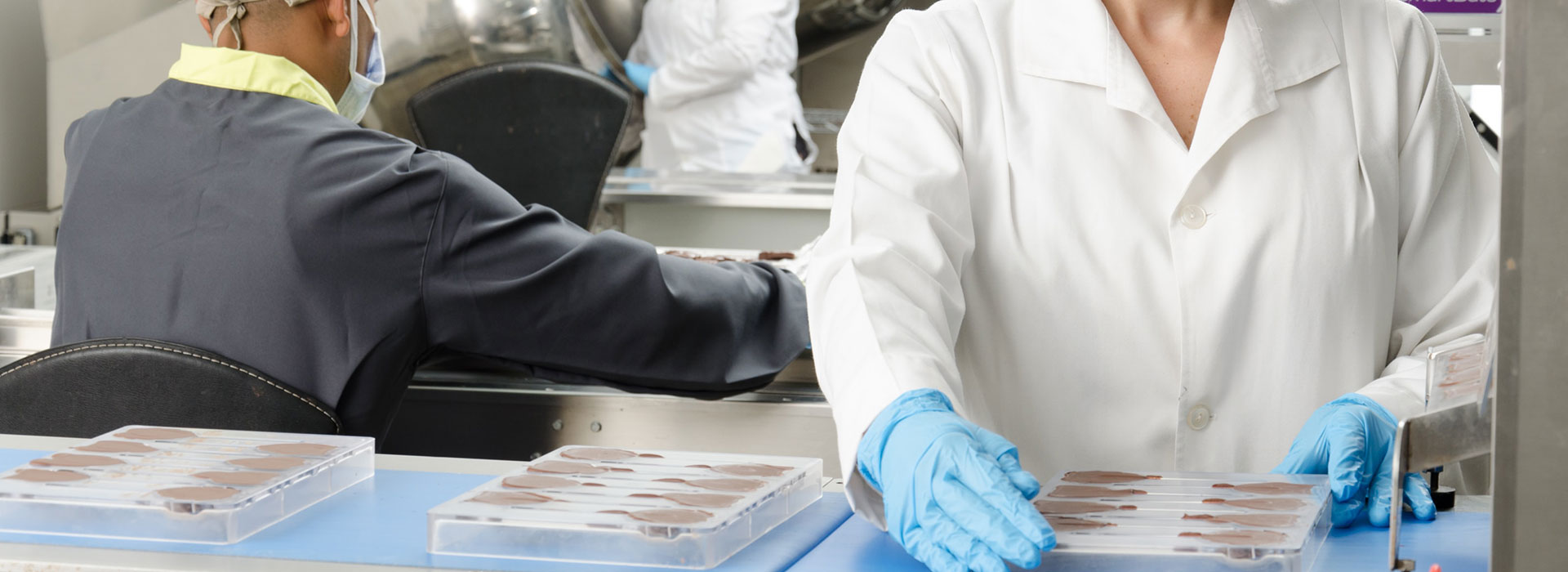
Products for horses
Products for cattle
Products for sheep
Products for goats
Products for pigs
Products for chickens
Products for turkeys
Products for geese
Products for pigeons
Products for dogs
Products for cats
Products for fish
Products for rabbits
Products for camels
Poliovin
Suspension for injection
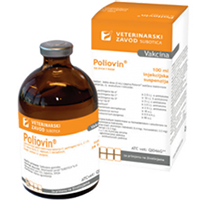


Target animal species:
Sheep, goats, catle and camels.
Active substance:
- Clostridium perfringens type A and alfa toxoid (≥ 2,5 IU anti-alpha*)
- Clostridium perfringens type C and beta toxoid (≥ 10 IU anti-beta*)
- Clostridium perfringens type D and epsilon toxoid (≥ 5 IU anti-epsilon*)
- Clostridium novyi type B and toxoid (≥ 3,5 IU anti-novyi*)
- Clostridium septicum and toxoid (≥ 2,5 IU anti-septicum*)
- Fusobacterium necrophorum (≥ 40 AU*)
- Staphylococcus aureus (≥ 0,5 AHU*)
- Arcanobacterium pyogenes (≥ 80 AU.*)
1 dose (2 ml) of the vaccine contains:
Inactivated bacterial cultures:
* antibodies titer in ml of serum
* AU- agglutinating unit
* AHU – antihemolytic unit
Indications:
Active immunization of target animal species against infection caused by Clostridium perfringens, types A, C and D, Clostridium septicum, Clostridium novyi type B, Fusobacterium nechrophorum, Staphylococcus aureus and Arcanobacterium pyogenes.
At least 14 days after revaccination titer reaches its highest level (second dose of vaccine).
According to field trials data, the immunity lasts for at least one year.
Amounts to be administered and administration route:
Sheep and lambs: 2 mL
Goats and kids: 2 mL
Cattle and calves: 5 mL
Camels: 5 mL
The vaccine is administered exclusively subcutaneously into the knee fold, the neck area or the chest behind the blade (for sheep and goats) and the neck area (for cattle and camels), using the principles of asepsis and antisepsis (injection administered at the site where the skin is clean and dry, to avoid the possibility of infection).
Primary vaccination: administer two doses within an interval of 3 weeks (21 days)
Booster vaccination: administer one dose every 12 months.
Withdrawal period:
Zero (0) days.
Packaging:
Bottle, 100 mL
Bottle, 250 mL
* not registered for all target animal species in all territories
* not all pack sizes may be marketed
Gopavak
Suspension for injection
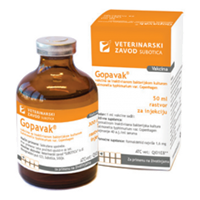


Target animal species:
Pigeons.
Active substance:
- Salmonella typhimurium var. Copenhagen min. 40 A.U./mL
1 dose (1 mL) of vaccine contains:
Indications:
Active immunization of pigeons against infections caused by Salmonella typhimurium var. Copenhagen.
Amounts to be administered and administration route:
For subcutaneous (s.c.) use.The vaccine is administered subcutaneously in the neck at a dose of 1 mL, twice in the period of 14 days.
Withdrawal period:
Zero (0) days.
Presentation:
Bottle 50 mL (50 doses)
ERY-LIP
Emulsion for injection
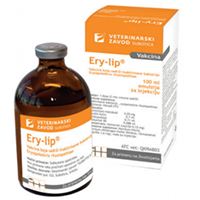

Target animal species:
Pigs.
Active substance
- Inactivated bacteria Erysipelothrix rhusiopathiae
Indications for use
Active immunization of pigs against swine erysipelas (diamond skin disease).
Amounts to be administered and administration route:
The dosage of the vaccine is 2 mL.The vaccine is administered once s.c. (behind the ear) at the dosage of 2 mL. All healthy animals over the age of 3 months are vaccinated. Depending on the epizootological situation, vaccination can be performed on individuals younger than 3 months and on piglets not more than 3 weeks old. Individuals vaccinated at the age younger than 3 months should be revaccinated 6 - 8 weeks later after the first vaccination. Pregnant sows are vaccinated in the first third of pregnancy, and revaccinated 5-6 weeks after the parturition.
Withdrawal period:
Zero (0) days.
Presentation:
Bottle 100 mL (50 doses)
LASOVAK
Lyophilisate and solvent for suspension for injection
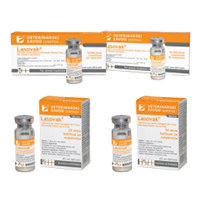


Target animal species:
Chickens and turkey poults.
Active substance:
1 dose of the vaccine contains:
- Live lentogenic Newcastle disease virus, La Sota strain 106,0 - 107,0 EID50
Indications
Active immunization of chickens and poults against Newcastle disease.
Amounts to be administered and administration route:
For oculo-nasal application and aerosol application
Oculo-nasal application:
0,1 mL i.e. two drops of the vaccine after reconstitution in a suitable solvent
Aerosol application:
1000 doses of the vaccine should be dissolved in 250 mL of distilled water.
Withdrawal period
Zero (0) days.
Presentations:
1 vial with lyophilisate (25 doses) and 1 vial with solvent (2,5 mL)
1 vial with lyophilisate (50 doses) and 1 vial with solvent (5 mL)
5 vials with lyophilisate (5 x 1000 doses) and 5 vials with solvent (5 x 100 mL)
5 vials with lyophilisate (5 x 2000 doses) and 10 vials with solvent (10 x 100 mL)
PEST-OL
Emulsion for injection
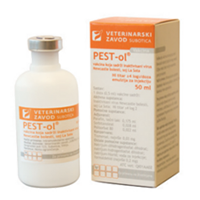


Target animal species:
Laying hens prior to onset of laying.
Active substance:
One 0.5 mL dose of the vaccine contains:
- Inactivated virus of the Newcastle disease, La Sota strain: HI titer* ≥4 log 2
*antibody titer in the serum of vaccinated chickens determined by applying the hemagglutination inhibition method
Indications:
Active immunization against the Newcastle disease (atypical avian influenza).
The time needed for immunity to develop: 3 weeks.
The duration of immunity: immunity lasts until the end of the production cycle.
Amounts to be administered and administration route:
For intramuscular use.The vaccine is administered intramuscularly in the chest, in the dose of 0.5 mL.The vaccine is given to birds when they are between 16 and 20 weeks old, but not later than 3 weeks before the laying of eggs is expected. Prior to administering the PEST-ol® vaccine, birds should be immunized with live vaccine against atypical avian influenza (Lasovak®). The period between administering the live vaccine and the PEST-ol® vaccine should be at least 2 weeks. Best results are achieved if that period is 6 weeks or more.
Withdrawal period:
Zero (0) days
Presentation:
Bottle 50 mL (100 doses)
BRONED-OL
Emulsion for injection
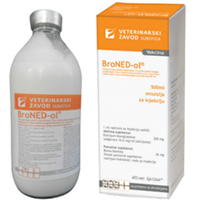

Target animal species:
Chickens.
Active substance:
1 dose (0,5 mL) of vaccine contains:
- Inactivated Newcastle disease virus (strain La Sota) ≥ 6 log 2 HU/dose
- Inactivated Infectious bronchitis virus (strain H52) ≥ 6 log 2 HU/dose
- Inactivated virus of Egg drop syndrome (strain BC14) ≥ 5 log 2 HU/dose
Indications:
Active immunization of breeder and layer pullets against of Egg drop syndrome, Infectious bronchitis ad Newcastle disease.
Period required for develop of immunity: 3 weeks.
Duration of immunity: immunity lasts until the end of the production cycle.
Amounts to be administered and administration route:
1 dose of vaccine is 0.5 mL. The vaccine is administered s.c. in the neck or i.m. into the pectoral musculature. Poultry are vaccinated at the age of 16-18 weeks, ie. not less than 4 weeks before the expected laying egg. Before using BRONED-OL® vaccine, chickens must be vaccinated with live vaccines against infectious bronchitis and Newcastle disease. The time between the administration of live vaccine and booster vaccination with BRONED-OL® vaccine should not be less than 2 weeks. The best booster effect is achieved 6 weeks after the live vaccine.
Withdrawal period:
Zero (0) days
Presentation:
Bottle 250 mL (500 doses)
KILAPIN
Lyophilisate and solvent for suspension for injection
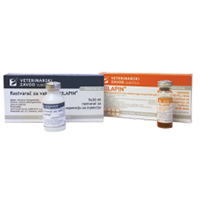

Target animal species:
Pigs.
Active substance:
1 dose (1ml) of vaccine contains:
- Live attenuated classical swine fever virus (China strain) minimum 100 PD50
Indications:
Active immunization against classical swine fever.
Amounts to be administered and administration route:
The vaccine is applied intramuscularly in a 1ml dose, regardless of the age of the pig. After reconstitution in an appropriate amount of the enclosed solvent (1 dose is reconstituted in 1mL of solvent), the vaccine is only applied intramuscularly, namely in the inside of the thigh for younger categories, and in the neck musculature for adult animals.
Withdrawal period:
Zero (0) days.
Presentations:
5 vials x 10 doses of vaccine and 5 vials x 10 mL of solvent.
5 vials x 20 doses of vaccine and 5 vials x 20 mL of solvent.
MORBIVAK
Lyophilisate and solvent for suspension for injection
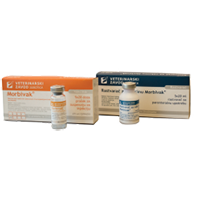

Target animal species:
Pigs.
Active substance:
One dose (1ml) of reconstituted vaccine contains:
- Live attenuated virus of Aujeszky’s disease (Bartha strain), 103,5 – 105,0 TCID50
Indications:
Active immunization of healthy pigs and piglets against Aujeszky’s disease.
The immunity is developed within 14 days and after revaccination, animal protection lasts one year.
Amounts to be administered and administration route:
The vaccine needs to be applied subcutaneously in the amount of 1mL for all categories of pigs. All piglets shall be vaccinated when they are 5 weeks old, at the earliest, and shall be revaccinated after 2-3 weeks The immunity is developed within 14 days and after revaccination, animal protection lasts 12 months.
Withdrawal period:
Zero (0) days
Presentation:
5 vials x 20 doses of vaccine and 5 vials x 20 mL of solvent.
Gentamicin sol.
Solution for injection
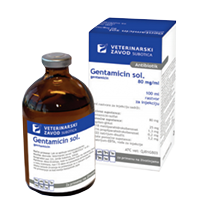


Target animal species:
Cattle, pigs and dogs.
Active substance:
- Gentamycin (as gentamycin-sulphate) 80 mg/ml
1 mL of solution for injection contains:
Indications:
The therapy of bacterial infection caused by microorganisms sensitive to gentamicin after antibiogram, gastrointestinal, urogenital and respiratory infection, infections of skin and soft tissues.
Amounts to be administered and administration route:
For intramuscular use - The medicinal product is administered i.m. twice a daily, every 12 hours (morning - evening) at a dose of 2 mg of gentamycin per 1 kg of body weight for all animals (or 4 mg of gentamycin per kg of body weight per day).
For large animals (cattle and pigs) 2.5 mL / 100 kg body weight and 1 mL per 40 kg of body weight every 12 hours.
For dogs on the first day of treatment 0.5 mL per 10 kg of body weight twice a day and during the other days of treatment 0.25 mL per 10 kg of body weight once a daily.
Do not apply the amount of the drug more than 20 mL for large animals or 10 mL for small animals on one injection site.
The treatment lasts 3 – 5 days.
Withdrawal period:
Due to the accumulation of gentamicin in the liver, kidneys and at the site of application,repeated treatment with gentamicin during the withdrawal period must be avoided.
Cattle meat and intestines: 192 days
Meat and intestines of pigs: 146 days
Cattle milk: 8 days
Presentation:
Bottle 100 mL
Hemutin 2%
Premix for medicated feed
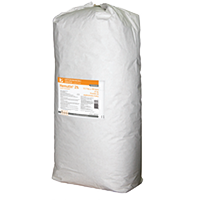


Target animal species:
Pigs and poultry.
Active substance:
- Tiamuline-hydrogen fumarate 20 mg
1g of the premix for medicated feed contains:
Indications:
Pigs:
Treatment of Bloody diarrhea (Brachyspira (Serpulina) hyodysenteriae) and other intestine infections caused by microorganisms sensitive to tiamuline, included intestinalis spirochetosis colitis (Brachyspira (Serpulina) pilosicoli) and ileitis (Lawsonia intracellularis). The treatment of respiratory diseases: pneumonia enzootica (Mycoplasma hyopneumonie) and other infections of pigs caused by microorganisms sensitive to tiamuline.
Poultry:
Treatment of respiratory infections of poultry caused by mycoplasmas (CRD) and secondary infections caused by microorganisms sensitive to tiamuline.
Amounts to be administered and administration route:
For oral use (mixed with feed).
| Animal species | Daily terapeutic dose of tiamuline-hydrogen fumarate | Dose (kg Hemutin® 2% / 1 t of feed) | The length of treatment(days) |
|---|---|---|---|
| Pigs | 5 – 10 mg/kg t.m. | 5 – 10 mg/kg t.m. | 7-10 |
| Severe forms of the infection 10 kg per 1 t of feed (1 kg per 100 kg of feed) | 7-10 | ||
| Poultry | 25 mg/kg t.m. | 25 kg per 1 t of feed (2,5 kg per 100 kg of feed) | 5 |
Withdrawal period:
Pigs: Meat, offal, and other edible tissues: 5 days
Poultry: Meat, offal, and other edible tissues: 3 days
It is not used in egg laying poultry.
Presentation:
Bag 25 kg
Hemutin CTC
Premix for medicated feed
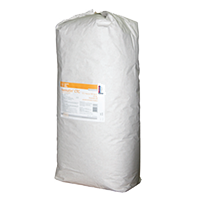


Target animal species:
Pigs.
Active substance:
- Tiamuline-hydrogen fumarate 33,3 mg
- Chlortetracycline (as chlortetracycline hydrochloride) 100 mg
Indications:
Treatment of pigs infections caused by microorganisms sensitive to tiamuline and chlortetracycline:
Respiratory infections: Enzootic pneumonia (Mycoplasma pneumoniae) and other diseases caused by mycoplasmas, pleuropneumonia (Actinobacillus pleuropneumoniae), atrophic rhinitis (Bordetella bronchiseptica, Pasteurella multocida) and secondary bacterial pneumonias.
Gastrointestinal infections: Swine dysentery (Brachyspira (Serpulina) hyodysenteriae associated with Campylobacter (Vibrio) coli, Fusobacterium necrophorum, Bacteroides spp., Clostridium perfrigens), colibacillosis , necrotic enteritis (Clostridium perfrigens type C) associated with Salmonella choleraesuis, secondary bacterial infections after transmissible gastroenteritis (TGE).
Urogenital infections: cystitis, nephritis, metritis, MMA syndrome in sows.
Amounts to be administered and administration route:
Hemutin® CTC is given mixed into the feed, during 7 to 10 days,
Piglets up to 8 weeks of age - 2 kg of premix (corresponding to 66.6 g of thiamuline hydrogen fumarate and 200 g of chlortetracycline) per 1t of feed, or 200 g of premix per 100 kg of feed
Piglets older than 8 weeks - 3 kg of premix (corresponding to 99.9 g of thiamuline hydrogen fumarate and 300 g of chlortetracycline) per 1 ton of feed, or 300 g of premix per 100 kg of feed
In severe infections the therapy lasts longer:
Piglets up to 8 weeks of age - 3 kg of premix per 1 ton of feed, or 300 g per 100 kg of feed
Piglets older than 8 weeks - 4.5 kg of premix per 1 ton of feed, or 450 g per 100 kg of feed.
Withdrowal period:
Meat and edible tissues of pigs: 10 days.
Presentation:
Bag 100 g; Bag 1 kg; Bag 5 kg; Bag 25 kg
Hemutin S
Solution for injection
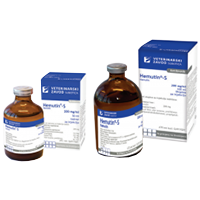


Target animal species:
Pigs.
Active substance:
- Tiamulin 200 mg
1 mL of solution for injection contains:
Indications:
Treatment of pigs bloody diarrhea, micoplasmal pneumonia, micoplasmal polyserositis and polyarthritis of pigs
Amounts to be administered and administration route:
The drug is applied intramuscularly (i.m.), in the following doses:
Blood diarrhea therapy: 10 mg thiamuline / kg TM, corresponding to 0.5 ml / 10 kg TM, once.
Treatment of mycoplasmal pneumonia: 10 - 15 mg thiamuline / kg TM, corresponding to 0.50 - 0.75 ml / 10 kg TM / day, for 3 - 5 days.
Treatment of mycoplasmal polyserositis and polyarthritis: 15 mg thiamuline / kg TM, corresponding to 0.75 ml / 10 kg TM / day, for 3 days.
Withdrawal period:
Meat and edible tissues of pigs: 28 days
Presentation:
Bottle 50 mL; Bottle 100 mL
Neomicin 70
Premix for medicated feed
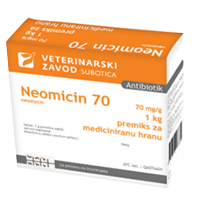


Target animal species:
Pigs, foals, calves, kids, lambs and poultry.
Active substance:
- Neomycin (as neomycin sulphate) 70 mg
1 g of premix for medicated feed contains:
Indications:
Treatment of acute and subacute, primary and secondary infections of gastrointestinal tract in targeted animal species, caused by neomycin-sensitive microorganisms (above all with E.coli and Salmonella spp)
Amounts to be administered and administration route:
The drug is administered orally, mixed with feed.
The dose of neomycin sulfate is:
- for calves, foals, lambs, and kids 10-20 mg / kg b.w.
- for pigs 10-15 mg / kg b.w.
- for poultry 10-30 mg / kg b.w.
In practical application, the medicine Neomycin 70 is dosed in the amount of 3-3.5 kg / t of feed or 3-3.5 g / kg of feed. It is applied daily for 5-7 days.
The required amount of medicine is best mixed with a smaller amount of feed before mixing with the total required amount of feed to ensure even distribution of the medicine in the feed and proper dosage.
Withdrawal period:
Meat and edible tissues of pigs, calves, lambs, foals, kids, and broilers: 14 days. It is not used in egg laying poultry.
Presentation:
Bag 1 kg
Neomicin 245
Oral powder
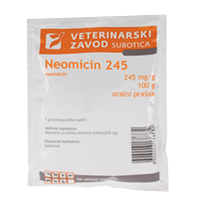


Target animal species:
Pigs, foals, calves, kids, lambs and poultry.
Active substance:
- Neomycin (as neomycin-sulphate) 245 mg
1 g of oral powder contains:
Indications:
Treatment of acute and subacute, primary, and secondary infections of gastrointestinal tract in targeted animal species, caused by neomycin-sensitive microorganisms (above all with E. coli and Salmonella spp)
Amounts to be administered and administration route:
The drug is administered orally, in drinking water.
The dose of neomycin sulfate is:
- for calves, foals, lambs, and kids 10-20 mg / kg body weight
- for pigs 10-15 mg / kg body weight
- for poultry 10-30 mg / kg body weight.
In practical application, the medicine Neomycin 245 is dosed in the amount of 5 g / 10 liters of water or 0.5 g / 1 liter of water. The drug is applied daily for 5-7 days.
The required amount of drug is best mixed with a smaller amount of water before mixing with the total amount of water required to ensure even distribution of the drug and proper dosage. It is necessary to prepare a fresh solution every day.
Withdrawal period:
Meat and edible tissues of pigs, calves, lambs, foals, kids, and broilers: 14 days. It is not used in egg laying poultry.
Presentation
Bag 100 g; Bags 25x20 g
Oksitetraciklin LA
Solution for injection
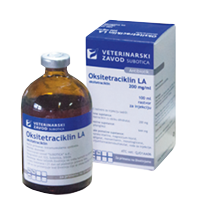


Target animal species:
Cattle, pigs and sheep
Active substance:
- Oxytetracycline (as oxytetracycline dihydrate) 200 mg
1ml of solution for injection contains:
Indications:
Treatment of bronchopneumonia, mastitis, and metritis in cattle, as well as bronchopneumonia in pigs and sheep caused by microorganisms susceptible to oxytetracycline.
Amounts to be administered and administration route
For intramuscular use.
Recommended dose for all animals is 20mg/kg of body mass, i.e. 1ml of Oksitetraciklin LA medicine on 10kg of body mass. The medicine is administered one time only, and in severe disease cases the dose may be reapplied after 3 to 4 days.
Withdrawal period:
Meat and edible tissues:
- Cattle - 36 days
- Pigs - 36 days
- Sheep - 24 days
The medicine is not to be used in animals whose milk is used for human consumption.
Presentation:
Bottle 100 mL
Streptomicin sulfat
Oral powder
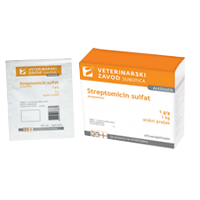


Target animal species:
Foals, calves, pigs, piglets and poultry.
Active substance:
- Streptomycin sulphate 1g
1 g of oral powder contains:
Indications:
The medicinal product is targeted for the treatment of many gastrointestinal infections (colibacillosis, pasteurellosis, salmonellosis, vibrionic dysentery, various types of enteritis) and other infections caused by microorganisms sensitive to streptomycin in foals, calves, pigs, piglets and poultry.
Amounts to be administered and administration route:
The drug is administered orally in drinking water, milk or milk substitute.
The drug is applied in the following doses:
- Calves and foals - 5 g of medicine (1 meas. cup) / 100 kg of b.m., 2 x a day (every 12 hours)
- Pigs and piglets - 1 g of medicine per 50 kg of b.m., 2 x a day (every 12 hours)
- Poultry - 1 g of medicine per 3 L of water or 5 g (1 meas. cup) per 15 L of water
Withdrawal period:
Meat and edible tissues: 10 days. It is not used in egg laying poultry.
Presentation:
Bag 5 g; Bag 100 g; Bag 500 g; Bag 1kg
Tilozin 200
Solution for injection
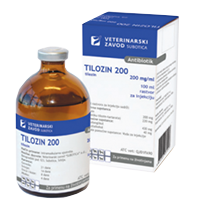


Target animal species:
Cattle, sheep, pigs and dogs.
Active substance:
- Tilozin 200 mg
1 mL of solution for injection contains:
Indications:
The treatment of respiratory, gastrointestinal and other infections caused by microorganisms sensitive to tylosin (enzootic bronchopneumonia, atrophic rhinitis, tonsillitis, tracheobronchitis, dysentery, non-specific enteritis , mastitis) in cattle, sheep pigs and dogs.
Amounts to be administered and administration route
The drug is administered i.m. at a daily dose, or the amount of drug as follows:
- Cattle: 5 – 10 mg/kg b.w. or 2,5 – 5 ml solution for injection /100 kg t.m.
- Calves: 5 – 10 mg/kg b.w. or 1,25 – 2,5 ml solution for injection /50 kg t.m
- Pigs: 5 – 10 mg/kg b.w. or 1,25 – 2,5 ml solution for injection /50 kg t.m.
- Piglets: 5 – 10 mg/kg b.w. or 0,25 – 0,5 ml solution for injection/10 kg t.m.
- Sheeps: 10 mg/kg b.w. or 1 ml solution for injection /20 kg t.m.
- Dogs: 10 mg/kg b.w. or 0,5 ml solution for injection /10 kg t.m.
The medicinal product is administered once a day, and the treatment lasts for 3 – 5 days.
Wthdrawal period:
Meat and offal of cattle, sheep and pigs: 28 days.
Presentation:
Bottle 100 mL
Sulfamidin
Oral solution
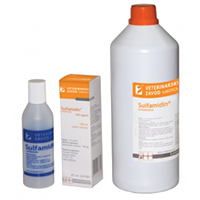


Target animal species:
Broilers, breeder layers, parent layers, pigeons.
Active substance:
- Sulfadimidine-sodium 160 mg
1ml of oral solution contains:
Indications:
Treatment of infections caused by organisms susceptible to sulfadimidine (chicken coccidiosis, infectious coryza in poultry, chicken white diarrhea and fowl typhoid, contagious enteritis in pigeons (paratyphoid)).
Amounts to be administered and administration route:
The medicine is administered orally, by adding it into drinking water.
Sulfamidin is used in doses of 50 to 200mg per kg of body weight. Sulfamidin® is used in doses of 6.25 to 12.5ml per 1 liter of drinking water. For treatment of pigeons, it is used in doses of 12.5ml of Sulfamidin® per 1 liter of drinking water.
It is recommended to double the concentration of the medicine on the first day of treatment. Therapy is conducted during 3 to 5 successive days.
The dose of the medicine should be adjusted to the current water consumption so that each bird receives the recommended dose.
Treatment of coccidiosis should be conducted according to the 3-2-3 pattern, which means 3 days of therapy, 2 days without therapy, and the therapy is then repeated for another 3 days.
Withdrawal period:
Meat, ofal and other edible tissues of broilers: 14 days
The medicine is not to be administered to egg laying hens.
Presentation:
Botlle 100 mL; Botlle 1000 mL
Hemosul-P
Oral powder
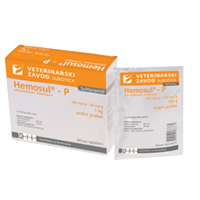


Target animal species:
Pigs and calves.
Active supstance:
- Sulphametoxazole 100 mg
- Trimethoprim 20 mg
1 g of oral powder contains:
Indications
HEMOSUL®-P is indicated in treatment of infections caused by microorganisms sensitive to a combination of sulphamethoxazole and trimethoprim.
Amounts to be administered and administration route:
The drug is given orally, mixed with feed. The total daily dose (amount) of drug for all species of animals is 10 g of powder per 40 kg of body weight. The daily dose should be halved and you should give half a dose in the morning and half a dose in the evening (every 12 hours). The therapy lasts for 4 to 5 days, and up to 7 days.
Withdrawal period(s)
Pigs (meat and offal): 10 days
Calves (meat and offal): 14 days
Presentation:
Bag 100 g; Bag 1 kg:
Broj rešenja:
1 x 100 g: 323-01-00134-19-002
1 x 1 kg: 323-01-00135-19-002
Hemosul-S
Solution for injection
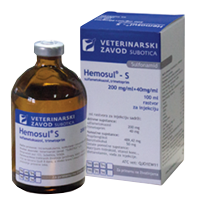


Target animal species
Pigs.
Active substances:
- Sulphametoxazole 200 mg
- Trimethoprim 40 mg
1 mL of solution for injection contains:
Indications
Treatment of infections caused by sulfamethoxazole and trimethoprim sensitive microroganisms.
Amounts to be administered and administration route
For intramuscular use - the terapeuthical dose is 1 mL of the product per 10-15 kg of b.w.
Withdrawal period
Meat and edible offal: 28 days.
Presentation:
Bottle 100 mL
Broj rešenja:
323-01-00136-19-002
Enrocin P
Oral powder
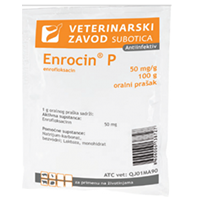


Target animal species:
Pigs, calves, broilers and turkeys for fattening.
Active substance:
- Enrofloxacin 50 mg
1 g of oral powder contains:
Indications:
Pigs:
Treatment of respiratory and gastrointestinal diseases caused by bacteria and mycoplasma sensitive to enrofloxacin (pasteurellosis, micoplasmosis, bacterial bronchopneumonia, colibacillosis, colisepticemia, salmonellosis), and multifactorial diseases ( atrophic rhinitis, enzootic pneumonia, MMA syndrome).
Calves:
Treatment of of respiratory and gastrointestinal diseases caused by enrofloxacin sensitive bacteria and mycoplasma ( pasteurellosis, bacterial bronchopneumonia, micoplasmosis, colibacillosis), Enrofloxacin should be used in cases when clinical experience, and whenever possible, sensitivity testing recommend it to be the drug of choice.
Broilers and fattening turkeys:
The therapy of infections caused by the following bacteria enrofloxacin sensitive:
Broilers:
- Mycoplasma gallisepticum
- Mycoplasma synoviae
- Avibacterium paragallinarum
- Pasteurella multocida
- Escherichia coli
Fattening turkeys:
- Mycoplasma gallisepticum
- Mycoplasma synoviae
- Pasteurella multocida
- Escherichia coli
Enrofloxacin should be used in cases when clinical expirience, and whenever possible, sensitivity testing recommend it to be the drug of choice.
Amount to be administered and administration route
Enrocin® P is given oraly mixed with feed. The recommended dose of enrofloxacin for pigs and calves is 2.5 – 5 mg/kg body weight and for pultry 10 mg/kg body weight, once a day. The length of the therapy is 3 to 5 days.
- Pigs: 2.5 – 5 mg/kg body weight (5-10 g of Enrocin P/ 100 kg of body weight), during 3-5 days. During salmonellosis and severe infections and its related complications, 5 mg/kg body wight during 5 days is recommended.
- Calves: 2.5 – 5 mg/kg body weight (5-10 g of Enrocin P/ 100 kg of body weight), during 3-5 days. During salmonellosis and respiratory infections and its related complications, 5 mg/kg body wight during 5 days is recommended.
- Poultry: 10 mg/kg body weight during 3-5 days; 5 days in treating mixed infections and chronic courses.
When mixing the product with poultry feed the dosage should be calculated in accordance to prescribed doses of enrofloxacin (10mg/kg.b.w. i.e. the drug Enrocin® P (0,2 g/kg b.w./daily):
Number of birds x Average body weight x 0,2 = Needed amount of product / day
Withdrawal period:
- Calves (meat and offal): 11 days
- Pigs (meat and offal): 10 days
- Poultry (meat and offal): 7 days
- Fattening turkeys: (meat and offal): 13 days
The product is not intended for egg laying hens producing eggs for human consumption and 14 days before the onset of laying.
Presentation:
Bag 100 g
Broj rešenja:
323-01-00166-18-002
Enrocin 10%
Oral solution
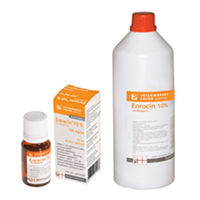


Target animal species:
Broilers and turkeys for fattening.
Active substance:
- Enrofloxacin 100 mg
1 mL of oral solution contains:
Indications:
Treatment of infections caused by the following bacteria susceptible to enrofloxacin:
Chickens
- Mycoplasma gallisepticum
- Mycoplasma synoviae
- Avibacterium paragallinarum
- Pasteurella multocida
- Escherichia coli
Turkey
- Mycoplasma gallisepticum
- Мусорlasma synoviae
- Pasteurella multocida
- Еscherichia coli
Amounts to be administered and administration route
The 10 mg enrofloxacin/kg bodyweight dissolved in drinking water Treatment for 3-5 consecutive days; for 5 consecutive days in mixed infections and chronic progressive forms. If no clinical improvement is achieved within 2-3 days, alternative antimicrobial therapy should be considered based on the antibiogram.
Withdrawal period
Treatment of infections caused by the following bacteria susceptible to enrofloxacin:
Chickens: Meat and offal: 8 days.
Turkeys: Meat and offal: 13 days.
Presentation:
Bottle 10 mL; Bottle 1000 mL
Broj rešenja:
l x 10 ml: 323-01-00057-17-001
l x 1000 ml: 323-01-00064-17-001
Enrocin S 10%
Solution for injection
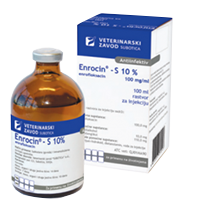


Target animal species:
Cattle and pigs.
Active substance:
- Enrofloxacin 100,0 mg
1 mL of solution for injection contains:
Indications:
Cattle:
- Treatment of respiratory infections caused by bacteria sensitive to enrofloxacin. Pasteurella multocida, Mannheimia haemolytica i Mycoplasma spp.
- Treatment of severe acute mastitis, gastrointestinal infection and septicemia caused by Eschericha coli sensitive to enrofloxacin.
- Treatment of acute mycoplasma arthritis caused by strains of Mycoplasma bovis sensitive to enrofloxacin, in Cattle not older than 2 years.
Pigs:
- Treatment of respiratory infections caused by bacteria sensitive to enrofloxacin: Pasteurella multicoda, Mycoplasma spp. and Actinobacillus pleuropneumoniae.
- Treatment of urinary and gastrointestinal infections caused by Escherichia coli sensitive to enrofloxacin.
- Treatment of MMA syndrome (metritis, mastitis, agalactia) caused by sa Escherichia coli and Klebsiella spp.
- Treatment of septicemia caused by Escherichia coli Escherichia coli sensitive to enrofloxacin.
Amounts to be administered and administration route
For subcutaneous or intramuscular use. Re-injections should be given at different sites. In order for the drug to be properly dosed and to prevent sub dosing, the body weight of the animal should be determined as accurately as possible.
Cattle:
- 5 mg enrofloxacin / kg TM, corresponding to 1mL drug / 20 kg TM, once daily for 3-5 days.The drug should be administered subcutaneously.
- No more than 10 mL should be given at one subcutaneous site. In case the required amount of drug exceeds 10 mL in calves and cattle, it is necessary to apply the drug in several places.
Pigs:
- 2.5 mg enrofloxacin / kg TM, corresponding to 0.5 mL drug / 20 kg TM, once daily by intramuscular injection for 3 days.
- Gastrointestinal infections or septicemia caused by Escherichia coli: 5 mg enrofloxacin / kg TM, corresponding to 1 mL of drug / 20 kg TM, intramuscularly once daily for 3 days.
- In pigs, injections should be given into the neck, into the base of the ear.
- No more than 3 mL of drug should be administered at one intramuscular site.
Withdrawal period:
Cattle:
- Meat and edible tissues: 14 days
- Milk: 7 days
Pigs:
- Meat and edible tissues: 13 days
Presentation:
Bottle 100 mL
Broj rešenja:
323-01-00329-16-001
Enrocin S 5%
Solution for injection
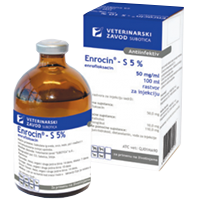


Target animal species:
Cattle, sheep, goats, pigs, dogs and cats.
Active substance:
- Enrofloxacin 50,0 mg
1 mL of solution for injection contains:
Indications:
Cattle:
- Treatment of respiratory infections caused by bacteria sensitive to enrofloxacin. Pasteurella multocida, Mannheimia haemolytica i Mycoplasma spp.
- Treatment of severe acute mastitis, gastrointestinal infection and septicemia caused by Eschericha coli sensitive to enrofloxacin.
- Treatment of acute mycoplasma arthritis caused by strains of Mycoplasma bovis sensitive to enrofloxacin, in Cattle not older than 2 years.
Sheep:
- Treatment of gastrointestinal infection and septicemia caused by Eschericha coli sensitive to enrofloxacin.
- Treatment of mastitis caused by Staphylococcus aureus i Escherichia coli.
Goats:
- Treatment of respiratory infections caused by bacteria sensitive to enrofloxacin.Pasteurella multocida, Mannheimia haemolytica i Mycoplasma spp.
- Treatment of gastrointestinal infection and septicemia caused by Eschericha coli sensitive to enrofloxacin.
- Treatment of mastitis caused by Staphylococcus aureus i Escherichia coli.
Pigs:
- Treatment of respiratory infections caused by bacteria sensitive to enrofloxacin: Pasteurella multicoda, Mycoplasma spp. and Actinobacillus pleuropneumoniae.
- Treatment of urinary and gastrointestinal infections caused by Escherichia coli sensitive to enrofloxacin.
- Treatment of MMA syndrome (metritis, mastitis, agalactia) caused by sa Escherichia coli and Klebsiella spp.
- Treatment of septicemia caused by Escherichia coli Escherichia coli sensitive to enrofloxacin.
Dogs:
- Treatment of gastrointestinal, respiratory and urogenital infections ( including prostatitis, adjuvant antibiotics therapy of pyometra) skin infections and otitis externa/media, caused by bacteria strain sensitive to enrofoxacin: Staphylococcus spp., Escherichia coli, Pasteurella spp., Klebsiella spp., Bordetella spp., Pseudomonoas spp. end Proteus spp.
Cats:
- Treatment of gastrointestinal, respiratory and urogenital infections ( including prostatitis, adjuvant antibiotics therapy of pyometra) skin and wound infections and otitis externa/media, caused by bacteria strains sensitive to enrofoxacin: Staphylococcus spp., Escherichia coli, Pasteurella spp., Klebsiella spp., Bordetella spp., Pseudomonoas spp. end Proteus spp.
Amounts to be administered and administration route
For subcutaneous or intramuscular use. Re-injections should be given at different sites. In order for the drug to be properly dosed and to prevent sub dosing, the body weight of the animal should be determined as accurately as possible
Cattle:
- 5 mg enrofloxacin / kg TM, corresponding to 1mL drug / 10 kg TM, once daily for 3-5 days. The drug should be administered subcutaneously.
- No more than 10 mL should be given at one subcutaneous site. In case the required amount of drug exceeds 10 mL in calves and cattle, it is necessary to apply the drug in several places
Sheep and goats:
- 5 mg enrofloxacin / kg TM, corresponding to 1mL drug / 10 kg TM, once daily for 3-5 days. The drug should be administered subcutaneously. No more than 6 mL should be given at one subcutaneous site
Pigs:
- 2.5 mg enrofloxacin / kg TM, corresponding to 0.5 mL drug / 10 kg TM, once daily by intramuscular injection for 3 days.
- Gastrointestinal infections or septicemia caused by Escherichia coli: 5 mg enrofloxacin / kg TM, corresponding to 1 mL of drug / 10 kg TM, intramuscularly once daily for 3 days.
- In pigs, injections should be given into the neck, into the base of the ear.
- No more than 3 mL of drug should be administered at one intramuscular site.
Dogs and Cats:
- 5 mg enrofloxacin / kg TM, corresponding to 0.5 mL drug / 10 kg TM, once daily by intramuscular injection for 5 days.
Withdrawal period:
Cattle:
- Meat and edible tissues: 14 days
- Milk: 7 days
Pigs:
- Meat edible tissues: 13 days
Sheeps and Goats:
- Meat and edible tissues: 14 days
- Milk: The drug is not used in lactating sheep and goats whose milk is intended for human consumption.
Presentation:
Bottle 100 mL
Broj rešenja:
323-01-00328-16-001
Flumekvin
Oral powder
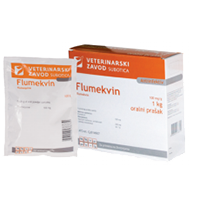


Target animal species:
Calves, lambs, pigs, poultry and fish.
Active substance:
- Flumequine 100 mg
1g of oral powder contains:
Indications:
- Calves, lambs, and pigs – treatment of bacterial infections of digestive, respiratory (salmonellosis, colibacillosis, and pasteurellosis), and genitourinary tract caused by microorganisms susceptible to flumequine.
- Poultry (chickens) – treatment of bacterial infections of digestive, respiratory (salmonellosis, colibacillosis, and pasteurellosis), and genitourinary tract caused by microorganisms susceptible to flumequine.
- Fish – treatment of septicemia (furunculosis, yersiniosis, vibriosis), chronical and secondary infections caused by bacteria susceptible to flumequine.
Amounts to be administered and administration route:
The medicine is administered by adding it to feed, drinking water or milk.
Calves and lambs:
- 1.8 – 2.2g/15kg of body mass (equivalent 12 – 15mg of flumekvin/kg b.m./day).
- The first half of dose should be added in the morning, and the other half after 12 hours, in the evening. Treatment lasts 5 days.
Pigs:
- 1.5 – 2.0g/10kg of body mass (equivalent 15 – 20mg/kg of active ingredients/day).
- The first half of dose should be added in the morning, and the other half after 12 hours, in the evening. Treatment lasts 3 – 5 days.
Poultry:
- Recommended dose of flumekvin is 12mg/kg of b.m./day for 3-5 days.
- The required quantity should be calculated in relation to consumption of feed or water.Considering the fact that the clinical state of the animal can influence the quantity of water and food consumed, in order to apply the recommended dose of flumekvin per 1kg of body weight, the quantity of medicine for mixing with food or adding to water must be precisely calculated.
Fish:
- Recommended dose of flumekvin is 12 – 20mg/kg of b.m./day for 5 days, that is 12 – 20g/100kg of fish
The upper recommended dose limit is indicated in chronic cases. For mature categories, the total daily dose of medicine is divided into 3 meals (it is administered in intervals of 4 – 6 hours), while for juvenile categories, all daily meals must contain medicine. The treatment lasts 5 days, and in the case of chronic infections and at lower water temperatures, it can last longer.
Withdrawal period
Poultry meat: 3 days.
Pig (piglet), calves, and lambs meat: 6 days.
Fish meat: 80oD (degree day). Withhdrawal period expressed in days depends on the temperature of water. At the temperature of 5oC, the withhdrawal period is 16 days and at the temperature of 20oC, it is only 4 days from the last medicine application.
The medicine should not be administered neither to egg laying hens nor 4 weeks prior to laying.
Presentation:
Bag 100 g; Bag1 kg.
Broj rešenja:
1 x 100 g: 323-01-00019-20-001
1 x 1 kg: 323-01-00020-20-001
Živimicin (CTC)
Oral powder



Target animal species:
Poultry (broilers) and pigs.
Active substance:
- Chlortetracycline hydrochloride 100 mg
1 g of oral powder contains:
Indications:
The drug is indicated for therapy of infection in broilers and pigs caused by microorganism sensitive to Chlortetracycline.
Amounts to be administered and administration route:
For oral use. The medicine is applied by adding to drinking water or mixing into the food
Poultry (broilers): Recommended dose of chlortetracycline is 30 to 50 mg/kg b.w/daily.
| Daily therapeutic dose of chlortetracycline (mg/kg b.w.) | Dose of (g Živimicin®/100 kg of food) | Dose of (g Živimicin®/100 L water) |
|---|---|---|
| 30 | 280 | 160 |
| 50 | 460 | 280 |
The therapy lasts for 5 to 7 days.
Pigs: Recommended dose of chlortetracycline is 20 mg/kg b.w/daily. The recommended dose of the drug is achieved by mixing 300 g of the drug per 100 kg of food or by adding 200 g of the drug in 100 liters of drinking water. The therapy lasts for 5 to 7 days.
Withdrawal period:
Broilers: Meat end edible tissues: 3 days
Pigs: Meat end edible tissues: 10 daysIt is not used in egg laying poultry.
Lek se ne koristi kod koka nosilja.konzumnih jaja.
Presentation:
bag 10 g; bag 1 kg; bag 25 kg
Broj rešenja:
1 x 10 g: 323-01-00326-17-002
1 x 1 kg: 323-01-00327-17-001
1 x 25 kg: 323-01-00328-17-001
Živimicin (vitamini + CTC)
Oral powder


Target animal species:
Poultry.
Active substances:
- Chlortetracycline hydrochloride 55 mg
- Vitamin A acetate 3 000 IU
- α-Tocopherol Acetate (vit. E) 1 mg
- Cholecalciferol (vit. D3) 300 IU
- Riboflavin sodium phosphate (vit. B2) 3 mg
- Pyridoxine Hydrochloride (vit. B6) 1 mg
- Nicotinamide (vit. B3) 13 mg
- Cyanocobalamin (vit. B12) 2 µg
- Menadione Sodium Bisulphite 1 mg
- Calcium Pantothenate 5 mg
1 g of oral powder contains:
Indications:
The application of the medication ŽIVIMICIN® is indicated in the following cases:The medication is intended for the treatment of poultry from various primary and secondary infections, especially those of gastrointestinal and respiratory tract, such as: bacterial diarrhoea, infectious synovitis, cholera, hexamitiasis, chronic respiratory disease (CRD).
Amounts to be administered and administration route:
In drinking water: 20 g of powder (4 tea spoons) on 5 L of water (which is equal to the chlortetracycline dose of 22 mg/kg of the body mass).This amount of water solution is enough for about 50 individuals whose average body weight is 1kg.
In feed: 10 kg of the medication to a ton of food, which corresponds to Chlortetracycline's concentration of 550 ppm.
The therapy lasts for 5 to 7 days.
Withdrawal period:
Meat end edible tissues of poultry: 2 days.
Presentation:
Bag 20 g; bag 1000 g
Novpiron
Solution for injection
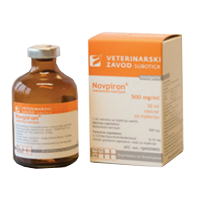


Target animal species:
Horses, foals, cattle and dogs.
Active substance:
- Metamizole sodium 500 mg
1ml of solution for injection contains:
Indications:
The application of NOVPIRON® is indicated in the following cases:
- Mitigation and elimination of pain and spasms, such as horse colic, gastrointestinal meteorism (gas colic), colic caused by tonic intestinal spasm, in small intestine obstipation, esophageal obstruction, horses’ lumbago, extremely painful wounds and injuries.
- Acute inflammatory processes of the locomotory apparatus (arthritis, bursitis, tendonitis and myositis).
- Reduction of pain during examination of animals, that is, painful diagnostic hospital procedures.
Amounts to be administered and administration route:
The medicine is administered parenterally, by intramuscular or intravenous injection.
Horses: 10-20 mL per animal ( 20-50mg/kg of body mass of metamisole)
Foals: 5-10 mL per animal
Cattle: 10-20 mL per animal ( 20-40mg/kg of body mass)
Dogs: 0.25 mL/4.5kg of body mass (28mg/kg of body mass)
The recommended dose should be administered once a day, but in severe cases can be repeated after 8 hours. The treatment is usually carried out within 5 days.
Withdrawal period:
Cattle (meat, ofal and other edible tissues): 12 days
Cattle (milk): 5 days
The medicine is not for use in horses intended for human consumption.
Presentation:
bottle 50 mL
Broj rešenja:
323-01-00049-18-001
Helmizol S
Solution for injection
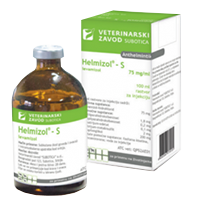


Target animal species::
Cattle, sheep and pigs.
Active substance:
- Levamisole hydrochloride 75 mg
1 mL of solution for injection contains:
Indications:
Helmizol® S is intended for treatment of numerous parasitic infections caused by nematodes.
Cattle and Sheep: Intestinal nematodes: Haemonchus spp., Trychostrongylus spp., Oesophagostomum spp., Nematodirus spp., Bunostomum spp., Chabertia ovina, Strongyloides papillosus, Cooperia spp. Lung nematodes: Dictyocaulus spp.
Pigs:
Ascaris suum and ”Larva migrans”, Strongyloides ransomi, Trichuris suis, Oesophagostomum spp., Hyostrongylus rubidus i Metastrongylus spp. The preparation acts on adult, as well as on larval forms of the parasites.
Amounts to be administered and administration route:
The drug is administered subcutaneously (s.c.) in cattle and sheep, and intramuscularly (i.m.) in pigs, in the following doses:
| Animal species | Dose |
|---|---|
| Cattle | 10 mL / 100 kg b.w. (equiv. 7.5 mg/kg b.w. of levamisole) |
| Sheep | 1 mL / 10 kg b.w. (equiv. 7.5 mg/ kg b.w. of levamisole) |
| Pigs | 1 mL / 10 kg b.w. or 10 ml/100 kg b.w. (equiv. 7.5 mg/ kg b.w. of levamisole) |
In order for the medicine to be dosed correctly, the body weight of the animal should be determined as accurately as possible. If animals are treated in groups and not individually, it is necessary to form groups according to their body weight, in order to avoid potential drug subdose or overdose.
Withdrawal period:
Meat and edible tissues: 28 days
The drug is not used in cattle and sheep whose milk is used for human consumption.
Presentation:
botle 100 mL
Broj rešenja:
323-01-00165-18-002
Ivermektin-S
Solution for injection
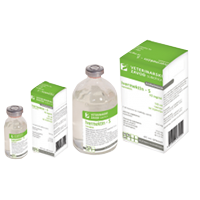


Target animal species:
Cattle, sheep and pigs.
Active substance:
- Ivermectin 10 mg
1mL of solution for injection contains
Indications:
Treatment of parasitic diseases caused by gastrointestinal and pulmonary nematodes, as well as skin parasites.
Cattle:
- Gastrointestinal nematodes (adult and the 4th stage larva): Haemonchus placei, Bunostomum phlebotomum, Oesophagostomum radiatum, Trichostrongylus axei, Nematodirus spp., Ostertagia spp., Cooperia spp.
- Pulmonary nematodes (adult and the 4th stage larva): Dictyocaulus viviparus
- Other helminths: Parafilaria bovicola
- Lice: Haematopinus eurysternus, Linognathus vituli, Solenopotes capillatus
- Mange mites: Sarcoptes scabiei var.bovis, Psoroptes equi var.bovis, Chorioptes bovis var.bovis
- Ticks: Boophilus microplus, B. decoloratus, Ornithodorus savigny
- Botfly: Hypoderma bovis, Hypoderma lineatum
- Flies: Chrysomia bezziana
Sheep:
- Gastrointestinal nematodes (adult and the 4th stage larva): Haemonchus contortus, Chabertia ovina, Ostertagia spp., Trichostrongylus spp. (adult), Nematodirus spp., Oesophagostomum spp.(adult), Trichuris ovis (adult)
- Pulmonary nematodes: Dictyocaulus filaria, Protostrongylus rufescens
- Mange mites: Sarcoptes scabiei var.ovis, Psoroptes equi var. ovis
- Botfly: Oestrus ovis (all larva forms)
Pigs:
- Gastrointestinal nematodes (adult and the 4th stage larva): Ascaris suum, Hyostrongylus rubidus, Oesophagostomum spp., Strongyloides ransomi (adult and somatic larva forms)
- Pulmonary nematodes (adult): Metastrongylus spp.
- Lice: Haematopinus suis
- Mange mites: Sarcoptes scabiei var. suis
Amounts to be administered and administration route:
The medicine is administered subcutaneously, one time only, in the following volumes: .
Cattle: 1 mL of medicine per 50kg of body mass (0.2mg of ivermectin per 1kg of body mass). The best way to administer the medicine is into the wrinkled skin on the neck. No more than 10mL of medicine should be administered at one injection site.
Sheep: 0.5 mL of medicine per 25kg of body mass (0.2mg of ivermectin per 1kg of body mass), subcutaneously into the neck. During the treatment of scabies in sheep, the medicine should be administered twice, with a 7-day interval.
Pigs: 1 mL of medicine per 33kg of body mass (0.3mg of ivermectin per 1kg of body mass), subcutaneously into the neck
The contact of treated and untreated animals should be prevented for at least 7 days following the treatment. In order to properly dose the medicine, the animal body mass should be determined as accurately as possible. If the animals are treated as a group, and not individually, it is necessary to form groups according to their body mass in order to avoid potential underdosage and overdosage.
Withdrawal period:
Cattle (meat and offal): 49 days
Cattle (milk): Not to be used in lactating cows whose milk is used for human consumption. Not to be used in cows and heifers in gestation at least 60 days before calving.
Sheep (meat and ofal): 42 days
Sheep (milk): Not to be used in lactating sheep whose milk is used for human consumption. Not to be used in sheep in gestation at least 60 days before lambing.
Pigs (meat and offal): 28 days
Presentation:
botle 30 mL; botle 100 mL.
Broj rešenja:
1 x 30 mL: 323-01-00330-16-001
1 x 100 mL: 323-01-00331-16-001
Ivermektin-P
premix for medicated feed
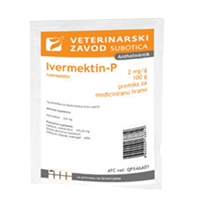


Target animal species:
Pigs.
Active substance:
- Ivermectin 2 mg
1 g of premix for medicated feed contains:
Indications:
Treatment of parasitic diseases in pigs caused by endo and ectoparasites.
- Intestinal nematodes: (adult and IV larval stadium): Ascaris suum, Hyostrongylus rubidus, Oesophagostomum spp., Strongyloides ransomi (adult and somatic larval forms)
- Lung nematodes: (adult): Metastrongylus spp.
- Lice: Haematopinus suis
- Itch mites: Sarcoptes scabiei var. suis
- Šugarci - Sarcoptes scabiei var. suis
*When applied to pregnant sows, before farrowing, it prevents transmission S. ransomes through milk to piglets.
Amounts to be administered and administration route:
The medication is administered mixed with feed. Peroral therapeutic dose for pigs is as follows:
0.5 g of the medication per 10 kg b.w. (equiv. 0.1 mg of ivermectin per kilogram of body mass).
The therapy lasts for 7 consecutive days.
| Category / weight of pigs | Dose (kg of premix/ton of feed) | Dose (g of premix / 100 kg of feed) |
|---|---|---|
| Up to 40 kg | 1 kg / 1 ton of feed | 100 g / 100 kg of feed |
| Over 40 kg | 1.2 kg / 1 ton of feed | 120 g / 100 kg of feed |
| Sows and boars | 5 kg / 1 ton of feedThe mixture prepared in this manner is to be administeredin the amount of 3 kg / 100 kg b.w. | 500 g / 100 kg of feedThe mixture prepared in this manner is to be administeredin the amount of 3 kg / 100 kg b.w. |
After the medication has been mixed with feed, it is given to pigs in growth phase (b.w. up to 40 kg and over 40 kg b.w.) as the only meal continuously for 7 days, while adult pigs are given in the amount of 1 kg of prepared mixture / 100 kg b.w. daily.
In order to achieve complete control of parasitic infections, it may be necessary to repeat the therapy with this drug after 21 days from the cessation of the initial therapy.
Pregnant sows should be treated for 14 to 21 days, before farrowing, to reduce the possibility of infection in piglets.
In order to dose the medication properly, the body mass of the animal should be determined as accurately as possible. If the animals are treated as a group, not individually, it is necessary to form groups according to their body mass, in order to prevent potential subdosage or overdosage of the medication.
Withdrawal period:
Pigs (meat end offal): 12 days
Presentation:
bag 100 g; bag 1 kg.
Broj rešenja:
1 x 100 g: 323-01-00186-17-001
1 x 1 kg: 323-01-00185-17-001
Ektanon
concentrate for dip emulsion
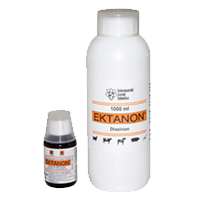


Target animal species:
Horses, cattle, sheep, goats, pigs, dogs.
Active substance:
- Diazinon 250 mg
1 mL of concentrate for dip emulsion contains:
Indications:
The preparation EKTANON® is intended for elimination of ectoparasites that parasitize domestic animals.
Horses and cattle: ticks (lxodidae), mange mites (Sarcoptes, Psoroptes, Chorioptes), lice (Anoplura,Malloplura, Mallopphaga) and flies (Brachycera).
Sheep and goats: mange mites (Sarcoptes, Psoroptes, Chorioptes), ticks (Ixodidae), lice (Anoplura).
Pigs: lice (Anoplura) and mange mites (Sarcoptes).
Dogs: ticks (Ixodidae), fleas (Ctenocephalides canis) and mange mites (Sarcoptes, Notoedres, Otodectes)
Amounts to be administered and administration route:
It is applied externally by bathing, spraying or washing as water suspension.
Cattle, horses and dogs: 1: 400 (i.e. 2.5 ml/l of water)
Goats and pigs: 1:1000 (i.e. 1 ml/l of water)
Sheep: 1:1000 (i.e. 100 ml/100 l of water) 20 days after shearing.
As after bathing in the pools animals always take out a certain amount of the solution (up to 10 %) on their bodies, refilling and concentration of the solution is performed by adding 35 mL of the preparation on each 10 L of added water.
Withdrawal period:
Meat: 35 days
The milk from the treated animals is not used for human consumption.
The product is not intended for horses whose products are intended for human consumption.
Presentation:
bottle 100 mL; bottle 1000 mL
Broj rešenja:
1 x 100 mL: 323-01-00218-15-001
1 x 1000 mL: 323-01-00219-15-001
Coffeinum cum natrii benzoate
Solution for injection
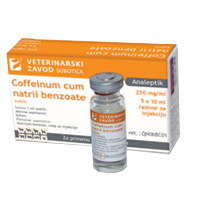


Target animal species:
Horses, foals, cattle, calves, sheep, pigs, dogs and cats.
Active substance:
- Caffeine 250 mg
1 mL rastvora za injekciju sadrži:
Indications:
The application of COFFEINUM CUM NATRII BENZOATE is indicated in the following cases:
- Collapse caused by infectious diseases, fatigue and stress
- Depression of respiratory center (breathing) including the one which occurs after the appliance of the depressor of the central nervous system (CNS) (general anesthetics, barbiturates, and opiate analgetics)
- Neonatal depression of respiration (asphyxia), exhaustion and weakness during the illness of animals.
Amounts to be administered and administration route:
The medicine is administered by subcutaneous, intramuscular, or intravenous injection.
Coffeinum cum natrii benzoate is to be applied in the following doses:
Horses, cattle: 2 - 3ml/100kg of body weight
Calves, foals, sheep, pigs, dogs, cats: 0.2 - 0.25ml/10kg of body weight
The application is performed where required, and the dosage can be repeated during the day (1.5 - 2 hours after the first application).
Withdrawal period:
Zero (0) days.
Presentation:
Bočica 5 x 10 ml; bočica 50 ml
Broj rešenja:
5 x 10 mL: 323-01-00048-18-001
50 mL: 323-01-00047-18-001
Glucosum
Solution for infusion
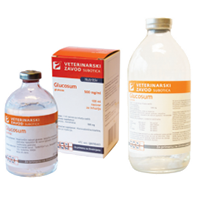


Target animal species:
Horses, cattle, sheep, pigs, dogs and cats
Active substance:
- Glucose anhydrous 500 mg (equivalent to 550 mg glucose monohydrate)
1 mL solution for infusion contains:
Indicatons:
Treatment of primary and secondary hypoglycemia and parenteral nutrition in cattle, horses, pigs, sheep, dogs and cats; treatment of ketosis (acetonemia) in cattle, as adjunctive therapy of pregnancy toxemia in sheep. It can be used for temporary relief of symptoms of cerebral edema and hypoglycemic coma and as a supportive therapy for poisoning, inflammatory and edematous processes.
Amounts to be administered and administration route:
Isotonic 5% glucose solutions can also be administered subcutaneously. If a larger amount of solution needs to be applied subcutaneously, the total amount should be applied in several places. The 5% glucose solution should not be administered at a rate greater than 10 ml / kg / h. Glucose solution does not contain electrolytes and should not be used alone to replace fluids. Hypertonic solution of glucose is administered only intravenously.
Glucose is applied in the following quantities:
| Glucose | 50% solution |
|---|---|
| Cattle and horses | 100-250 ml |
| Pigs | 30-100 ml |
| Sheep | 50-100 ml |
| Dogs and cats | 10-50 ml |
If is needed the treatment can be repeated, and if possible, another vein should be used. 5 % solution is prepared in the way that one portion of 50 % glucose is added to nine portions of injection water, respectively Ringer's solution or physiological saline solution.
Glucose is applied in the following quantities
| Glucose | 5% solution |
|---|---|
| Cattle and horses: | 500-2000 ml |
| Pigs: | 50-400 ml |
| Sheep: | 50-400 ml |
| Dogs and cats: | 50-400 ml |
Isotonic 5% glucose solutions can also be administered subcutaneously. If a larger amount of solution needs to be applied subcutaneously, the total amount should be applied in several places. The 5% glucose solution should not be administered at a rate greater than 10 ml / kg / h. Glucose solution does not contain electrolytes and should not be used alone to replace fluids.
Withdrawal period:
Zero (0) days.
Presentation:
bottle 100 mL; bottle 500 mL
Broj rešenja:
1 x 100 mL: 323-01-00319-18-001
1 x 500 mL: 323-01-00320-18-001
Parafer
Solution for infusion
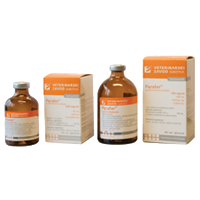


Target animal species:
Piglets.
Active substance:
- Trivalent iron (Fe3+) 100 mg (in the form of dextran complex)
1 mL of solution for injection contains:
Indications:
PARAFER® is intended for the prevention and treatment of microcytic hypochromic (iron deficiency) anaemia of piglets.
Amounts to be administered and administration route:
PARAFER® is applied once in the quantity of 2 mL per animal (equivalent to 200 mg of Fe-dextran). The drug is deeply intramuscularly (i.m.) injected on the inside of the leg, into piglets 2-3 days old.
Withdrawal period:
Zero (0) days
In cases of emergency slaughtering, the tissue from the injection site should be eliminated.
Presentation:
bottle 50 mL; bottle 100 mL
Broj rešenja:
1 x 50 mL: 323-01-00260-15-002
1 x 100 mL: 323-01-00261-15-002
Calcium borogluconicum
Solution for injection
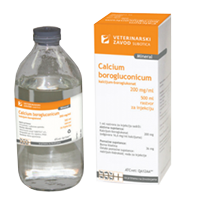


Target animal species:
Horses, cattle, sheep, goats, pigs and dogs.
Active substance:
- calcium borogluconate 200mg (equivalent to 16.6mg/mL of calcium)
1mL of solution for injection contains:
Indications
Tetany (grass tetany, transport tetany) tetanic convulsions in calves suffering from acute rhinitis, Puerperal pathology (paresis, hemoglobinuria, paraplegia), Allergic conditions, Inflammatory exudative conditions, Reduction of blood coagulation ability Bleedings, Some intoxications (carbon tetrachloride, oxalic acid, etc.).
Doziranje i način pripreme
Amounts to be administered and administration route:
| Horses, cattle: | 100–250 ml |
|---|---|
| Sheep and goats: | 25–50 ml |
| Pigs under 100 kg: | 10–50 ml |
| Pigs over 100 kg: | 50–100 ml |
| Dogs: | 5–20 ml |
The treatment can be repeated up to three times, at intervals of not less than 12 – 24 hours.
Withdrawal period:
Zero (0) days.
Presentation:
bottle 100 mL; bottle 500 mL
Broj rešenja:
1 x 100 ml: 323-01-00045-18-001
1 x 500 ml: 323-01-00046-18-001
Ketal
Oral solution
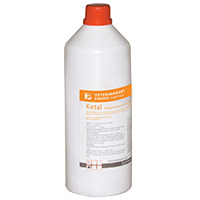


Target animal species:
Dairy cows.
Composition:
- Propylene glycol - 830 mg
- DL-methionine - 18 mg
- Cobalt (II)-sulphate heptahydrate - 0.10 mg
- Mangan (II)-sulfat, monohidrat - 0.2 g
- Manganese (II)-sulphate monohydrate - 0.20 mg
- Copper (II)-sulphate pentahydrate - 0.15 mg
- Excipients - Phosphoric acid, purified water.
1 mL of oral solution contains:
Indications:
Ketal is formulated as a dietary supplement for cows and it is intended for reduction of the risk of ketosis / acetonemia and to improve the overall body condition. It is applied immediately before calving, as well as in the period after calving in high-milk yielding cows in which a negative energy balance causes the appearance of subclinical ketosis. This condition results in a decrease in production results with increased susceptibility of the organism to other diseases (mastitis, metritis). Thanks to the content of propylene glycol, which is a source of energy, with the addition of methionine, an essential amino acid, Ketal has a positive effect on the energy status of the organism. In cases where the feed does not contain enough methionine, the use of Ketal has an extremely positive effect, and the intake of essential trace elements copper, cobalt and manganese has a positive effect on the metabolism of lipids, carbohydrates and proteins in the body.
Amounts to be administrated and administration route:
The preparation is applied by adding to drinking water. The daily dose is between 300-500 mL per animal. The daily dose can be mixed with the total daily amount of water and made available to the animals to drink at will, or to be divided and given to the animals twice (with morning and evening feeding) The treatment is repeated twice in the period of 4-5 days.
Withdrawal period:
Zero (0) days.
Presentation:
bottle 1000 mL
Promtselen
Solution for injection
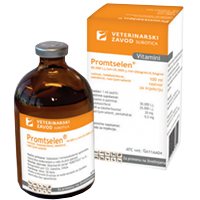


Target animal species:
Horses, cattle, sheep, goats, pigs, dogs, cats, chickens, ducks, geese and turkeys.
Active substance:
- Vitamin A-palmitate 50,000 IU
- Cholecalciferol 25000 IU
- RRR-α-tocopheryl acetate 20 mg
- Sodium selenite, pentahydrate 0.5 mg
1 mL of the solution for injection contains:
Indications:
Prevention and treatment of hypo and avitaminoses, selenium deficiency, breeding diseases in young animals (rachitis, degenerative myopathy, muscular dystrophy, ostheomalacia, keratitis, hemorrhagic diathesis, encephalomalacia, growth retardation), reproductive disorders (decreased fertility, sterility), as well as the improvement of general resistance of the organism to infectious diseases and stress.
Amounts to be administered and administration route:
The medication is administered to cattle and horses in the volume of 3 to 5 mL per 100 kg b.w., to calves, foals, sheep, goats and pigs 5 mL per 50 kg b.w., to piglets, lambs and kids 3 mL of the medication per 25 kg b.w., to newborn lambs and kids 1 to 2 mL; to dogs, cats and rabbits 0.5 mL per 5 kg b.w.
Chickens (100 chickens of 1 kg b.w.) get 10 mL of the medication in drinking water; ducklings, poults, goslings (100 individuals of 1 kg b.w.) get 20 mL of the medication, laying hens (100 individuals) get 20 to 30 mL of the medication, ducks (100 individuals) get 30 to 40 mL of the medication, geese (100 individuals) get 50 mL of the medication and turkeys (100 individuals) get 70 to 80 mL of the medication.
For therapeutic purposes, the medication can be used in intervals of one week, and for prophylactic purposes, once every two months.
The medicinal product is administered subcutaneously or intramuscularly as an injection, and in poultry in drinking water, twice, at 14-day intervals. Administered in prescribed doses, the medicinal product satisfies the needs for vitamins and selenium for 2-3 months.
Withdrawal period:
Meat: 28 days
Milk: Zero (0) days
Presentation:
bottle 100 mL
Broj rešenja:
323-01-00187-17-001
Vitamin AD3E S
Solution for injection
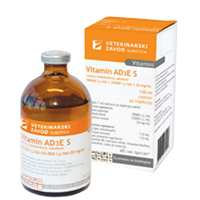


Target animal species:
Horses, cattle, sheep, goats, pigs, dogs, cats, chickens, ducks and turkeys.
Active substance:
- Vitamin A (Retinol palmitate) 50.000 IU
- Vitamin D3 (Cholecalciferol) 25.000 i.j.
- Vitamin E (α-tocopherol acetate) 20 mg
1 mL of solution for injection contains:
Indications:
It is applied on animals with high production results, on pregnant animals, animals during the lactating period and on young animals in the fast-growing stage. It is also applied in stressful conditions, as well as a support treatment in infectious diseases. In addition, it is indicated for hypo and avitaminoses, degenerative myopathy, liver dystrophy, rachitis, osteomalacia, tetany, keratitis, chicken blindness, sterility in females and for the reconvalescence phase.
Amounts to be administered and administration route
The preparation is administered intramuscularly, and for Poultry orally, mixed with drinking water.
| Species of animals (Mammals) | Amount of the drug in ml / kg b.w. |
|---|---|
| Horses and cattle | 3 - 5 ml / 100 kg b.w. |
| Calves, foals, sheep, goats, pigs | 5 ml / 50 kg b.w. |
| Piglets, lambs, kids | 3 ml / 25 kg b.w. |
| Dogs and cats | 0,5 ml / 5 kg b.w. |
| Species of animals (Poultry) | Amount of the drug in drinking water |
|---|---|
| 100 chicks b.w. ≈ 1 kg | 10 ml |
| 100 ducklings, turkeys b.w. ≈ 1 kg | 20 ml |
| 100 laying hens | 20 - 30 ml |
| 100 ducks | 30 - 40 ml |
| 100 turkeys | 70 - 80 ml |
The recommended dosage refers to a single treatment, which can be repeated every 2-3 months.If the vitamins are given as supportive treatment, it can be repeated in weekly intervals until full recovery.
Withdrawal period:
Meat: 28 days
Milk: 0 days.
Presentation:
bottle 100 mL
Broj rešenja:
323-01-00480-17-001
Vitamin C inj.
Solution for injection
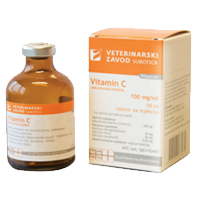


Target animal species:
Horses, cattle, pigs and dogs.
Active substance:
- Ascorbic acid (Vitamin C) 100 mg
1 mL of solution for injection contains:
Indications:
Hypovitaminosis and avitaminosis C (scurvy), bleeding diathesis of different etiology, supportive therapy in the treatment of infectious and contagious diseases, reconvalescence, poisoning (with bacterial toxins, alimentary), iatrogenic poisoning (with arsenic compounds, sulfonamides, barbiturates, etc.), functional sterility caused by avitaminosis C, treatment of stress, in case of primary and secondary anemia.
Ammounts to be administered and administration route
The product is to be administered as an intramuscular, subcutaneous, or slow intravenous injection.
It is to be administered once a day in doses of 10 – 20 ml to horses and cattle; 5 – 10 ml to pigs; and 1 – 5 ml to dogs.
The treatment lasts for a number of days, depending on the veterinary surgeon evaluation.
Withdrawal period:
Zero (0) days.
Presentation:
bottle 50 mL
Broj rešenja:
323-01-00188-17-001
Subovit-ol AD3E
Oral solution
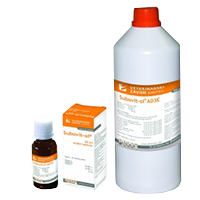


Target animal species:
Horses, cattle, sheep, goats, pigs, dogs, poultry, turkeys, ducks, pigeons, rabbits.
Composition:
- Vitamin A 50 000 IU
- Vitamin D3 25 000 IU
- Vitamin E 20 mg
1 mL of oral solution contains:
Indications:
The needs for these vitamins are especially pronounced in animals with high production results, in young animals, during the pregnancy and lactation, during various diseases, in the period of reconvalescence and stressful condition.
The preparation is intended to increase the body's resistance, better utilization of food, faster growth, and reduction of losses in chickens, better carrying capacity and reduction of stress in poultry during the vaccination, change of facility, transport and weather conditions.
Dosage and administration route:
The preparation is applied 3-5 days orally in drinking water in a following daily amount:
- Broilers up to 4 weeks of age - 5 ml per 10 L drinking water
- Broilers over to 4 weeks of age - 3 ml per 10 L drinking water
- Laying hens - 2 ml per 10 L drinking water
- Turkeys and ducks - 4 ml per 10 L drinking water
- Pigeons - 2 ml per 10 L drinking water
- Pigs, cattle and horses - 20 ml per 100 L drinking water
- Sheep, goats and dogs - 2 ml per 10 L drinking water
- Rabbits - 2 ml per 10 L drinking water
(1 ml = 20 drops of solution)
Presentation:
bottle 20 mL; bottle 1 L.
Vitamin C pulv.
Oral powder
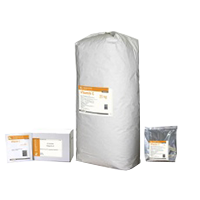


Target animal species:
Horses, cattle, pigs, poultry, turkeys, pigeons and rabbits.
Composition:
- Vitamin C 100 mg
1 g of oral powder contains:
Indications:
Stress, increased physical effort, infectious diseases, pregnancy, lactation and all other physical conditions that increase the need for this vitamin.
Dosage and administration route:
Vitamin C is administered orally after dissolving in drinking water for 3-5 days in the following doses:
Pigs - 5 g dissolved in 10 liters of drinking water
Poultry and turkeys - 10 - 20 g dissolved in 10 liters of drinking water
Laying hens - 20 - 30 g dissolved in 10 liters of drinking water
Pigeons and rabbits - 10 - 20 g dissolved in 10 liters of drinking water
Horses and cattle - 10 - 20 g per animal
Withdrawal period:
Zero (0) days
Presentation:
Bag: 20 g; Bag: 1 kg; Bag: 25 kg
Živimicin Tov
Oral powder
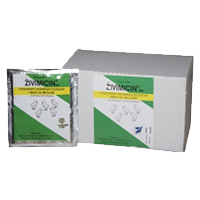


Target animal species:
Chickens, turkey poults and goslings.
Composition:
- Retinol palmitate (vit. A) - 3000 IU
- Cholecalciferol (vit. D3) - 300 IU
- Tocopherol (vit.E) - 1 mg (1 IU)
- Riboflavin (vit.B2) - 3 mg
- Cyanocobalamin (vit.B12) - 2 μg
- Menadion (vit. K3) - 1 mg
- Nicotinamide (vit. B3) - 13 mg
- Pyridoxine hydrochloride (vit B6) - 1 mg
- Pantothenic acid - 5 mg
- Ascorbic acid (vit. C) - 5 mg
- Copper sulphate pentahydrate - 500 μg
- Iron sulfate heptahydrate - 500 μg
- Zinc sulfate heptahydrate - 50 μg
- Manganese sulfate monohydrate - 500 μg
- Carrier up to - 1 g
1 g of powder for oral solution contains:
Indications:
The preparation is intended to increase the body's resistance, better food utilization, faster growth, reduction of losses in chickens, and reduction of stress in poultry during the vaccination, change of facility, transport and weather conditions. It is used for hypo and avitaminosis and as a supportive therapy for diseases of various etiologies in order to increase vitality and resistance or organism.
Dosage and administration route
Preparation is applied p.o. in drinking water or mixed with food. The recommended dosage refers to a single treatment. If the vitamins are use as supportive therapy, the application in the named doses can be repeated at weekly intervals.
The dose for 100 chickens is 10-20 g of preparations mixed with food or drinking water; for 100 geese or turkeys, the dose is 50 g of the preparation mixed in food or drinking water.
Presentation:
Bag 20 g.
Amivit
Oral powder
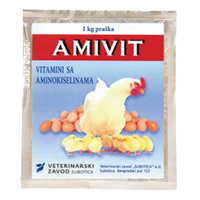


Target animal species:
Laying hens, chickens, turkeys, turkey poults.
Composition:
- Vitamin A (retinol) - 600 IU
- Vitamin D3 (Cholecalciferol) - 400 IU.
- Vitamin E (tocopherol) - 400 µg
- Vitamin B1 (Thiamine hydrochloride) - 720 µg
- Vitamin B2 (Riboflavin) - 1.40 mg
- Vitamin B3 (Nicotinamide) - 14 mg
- Vitamin B5 (Pantothenic acid) - 4 mg
- Vitamin B6 (Pyridoxine hydrochloride) - 1.40 mg
- Vitamin B12 (Cyanocobalamin) - 0.4 µg
- Vitamin K3 (Menadion) - 200 µg
- Folic acid - 22 µg
- Vitamin H (biotin) - 60 µg
- Vitamin C (Ascorbic acid) - 300 µg
- L-Threonine - 150 mg
- L-Tryptophan - 32 mg
- DL-Methionine - 100 mg
- L-Lysine - 170 mg
- L-Threonine - 15,000 mg
- L-Tryptophan - 3,200 mg
- Carrier up to - 1 g
1 g of oral powder contains:
Indications:
Amivit is a preparation intended to increase the body's resistance, better food utilization, faster growth, and reduction of losses in chickens, better laying eggs and reduction of stress in poultry due to vaccination, relocation, weather conditions.
Dosage and administration route:
For younger categories of poultry (chickens and turkeys) - 5 g of AMIVIT dissolve in 1 L of drinking water and give during the first 7 days of life, and later as needed, or periodically, at intervals of 3-5 days. 20 g of AMIVIT per 4 L of drinking water.
For adult categories of poultry and laying hens - 5 g of AMIVIT dissolve in 2 liters of drinking water or 20 g per 8 liters of water. Give periodically for 5-10 days.
Presentation:
Bag: 20 g; Bag:100 g; Bag: 1 kg.
Neosaningest
Oral powder
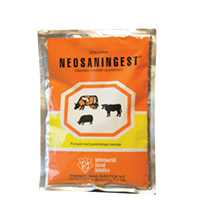


Target animal species:
Cattle, sheep and goats.
Composition:
- Calcium carbonate - 240 mg
- Calcium oxide - 20 mg
- Cobalt sulfate, heptahydrate - 20 µg
- Copper sulphate, pentahydrate - 500 µg
- Zinc sulphate, heptahydrate - 50 µg
- Manganese sulfate, monohydrate - 500 µg
- Iron sulphate, heptahydrate - 500 µg
- Lincure root (powder) - 20 mg
- Carrier (sugar crystal) up to 1g
1 g of oral powder contains:
Indications:
NEOSANINGEST® is a dietary supplement for ruminants and its composition helps the development of bacterial flora in the rumen, helps regulate the pH of the stomach, and contains microelements which participates in the metabolism of microorganisms, and allows better digestion of food in the ruminants.
Dosage and administration route:
The preparation is administered orally in drinking water in a daily amount of:
- Cattle - 200-500 g (depending on the severity of the case)
- Calves - 100-250 g
- Sheep and goats - 125 g
The preparation is administrated on the following way: the contents of one bag into 1-2 liters of water, mixing it well and applying it to the animal with the help of a bottle or a probe. In sheep, it is recommended to give the preparation by probe.
Presentation:
Bag: 200 g
Laksantiv
Oral powder
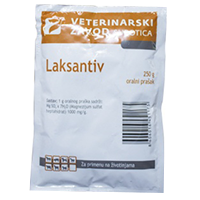


Target animal species:
Horses, cattle, sheep, goats, pigs, dogs and cats.
Composition:
- MgSO4 x 7 H2O (Magnesium sulphate heptahydrate) 1000 mg.
1 g of oral powder contains:
Indications:
All types of constipation, both small and large intestine, overcrowding and paresis of rumen, indigestion, gastritis, overcrowding due to various enteritis, poisoning with plant and chemical poisons. It is also used to evacuate gastrointestinal contents in pododermatitis.
Dosage and administration route:
- Horses: 1 g / kg body weight dissolved in 4 liters of lukewarm water (applied with a nasal probe).
- Cattle: 250 - 500 g dissolved in 5 - 8 liters of lukewarm water; apply orally with a feeding bottle.
- Sheep and goats: Apply 2 - 5 tablespoons dissolved in ¼ liter of water with a feeding bottle.
- Pigs: 25 - 125 g mixed with food
- Dogs: 5 - 25 g dissolved in water and given orally
- Cats: 2 - 5 g dissolved in water and given orally
Withdrawal period:
Zero (0) days.
Presentation:
bag 250 g
Prefoskal
Vitamin-mineral feed supplement


Target animal species:
Horses, cattle, sheep, goats, pigs, poultry and rabbits.
Composition:
- Vitamin A - 500,000 I.U.
- Vitamin D3 - 100,000 I.U.
- Choline - 10,000 mg
- Niacin - 1,000 mg
- Vitamin E - 500 mg
- Ca-pantothenate - 400 mg
- Vitamin B2 - 200 mg
- Vitamin B1 - 100 mg
- Vitamin B6 - 100 mg
- Vitamin B12 - 1 mg
- Calcium - 167 g
- Sodium chloride - 150 g
- Phosphorus - 80 g
- Magnesium - 13 g
- Zinc - 3.000 mg
- Iron - 2,000 mg
- Manganese - 1,500 mg
- Copper - 500 mg
- Iodine - 50 mg
- Selenium - 5 mg
- Antioxidant - 5,000 mg
- Aroma - 250 mg
1 kg of vitamin-mineral supplement contains:
Indications:
Prefoskal® serves as a dietary supplement for domestic animals to improve the body's supply of vitamins, micro and macro mineral elements.
Dosage and administration route:
The product is given to animals at will from a separate feeder, or mixed with feed in the following doses:
- Horses, Cattle: 2-4 tablespoons, per animal / day
- Calves, sheep, pigs: ½-1 tablespoon, per animal / day
- Piglets, lambs: ½ large spoons, per animal / day
- Rabbits, poultry: 1 tablespoon for 10-30 animals
Large spoon contains 20 g of preparation, 2% of the preparation is added to the mixture
Presentation:
bag 1 kg; bag 2 kg
Kanistop
Vitamin-mineral feed supplement


Target animal species:
Pigs and poultry.
Composition:
- Vitamin A - 150,000 I.U.
- Vitamin D - 30,000 I.U.
- Vitamin E - 1,500 I.U.
- Calcium - 50 g
- Sodium - 30 g
- Phosphorus - 25 g
- Magnesium - 12 g
- Zinc - 900 mg
- Iron - 300 mg
- Manganese - 250 mg
- Copper - 200 mg
- Iodine - 45 mg
- Selenium - 3.5 mg
1 kg Kanistop®-a sadrži:
Indications:
Kanistop® premix prevents and suppresses cannibalism in pigs and poultry. It reduces aggression, calms and normalizes their behavior. Its positive contribution is manifested especially in the case of deficient nutrition, incomplete utilization of feed, reproductive dissorders of animals, reconvalescence and stressful situations. With its composition, Kanistop® complements the daily meal of animals and enriches it with amino acids, micro and macro elements.
Kanistop® premix is enriched with proteins, essential amino acids, sulfur, micro and macro elements, B complex and other vitamins, growth factors and cellulose. Kanistop® fully satisfies the increased needs for amino acids: in poultry in the phase of feather formation, in pigs in intensive growth. Kanistop® contributes to the preservation and stabilization of animal health, accelerates growth and development, improves feed utilization and generally increases the productive results of poultry and pigs.
Dosage and administration route:
To prevent and suppress cannibalism, it is recommended to use Kanistop® in the amount of 5% in a dry or wet meal. A package of 1 kg of Kanistop® premix is added to 20 kg of complete pig and poultry feed. It is necessary to mix it well with feed. The animals are treated for 10-14 days, and longer if necessary.
Presentation:
bag 1 kg
Premix za jaja
Vitamin-mineral feed supplement for laying hens


Target animal species:
Laying hens.
Composition:
- Vitamin A - 125,000 I.J.
- Vitamin D3 - 20,000 I.J.
- Choline chloride - 3,000 I.J.
- Niacin - 300 mg
- Vitamin C - 200 mg
- Ca pantotenat - 100 MgSO4
- Vitamin E - 100 mg
- Vitamin B2 - 40 mg
- Vitamin B1 - 30 mg
- Vitamin B6 - 30 mg
- Vitami K3 - 20 mg
- Folic acid - 20 mg
- Vitamin B12 - 0.15 mg
- Calcium - 266 g
- Salt (NaCl) - 35 g
- Phosphorus - 16 g
- Manganese - 800 mg
- Zinc - 600 mg
- Iron - 400 mg
- Copper - 60 mg/li>
- Iodine - 4 mg
- Selenium - 1.5 mg
- Methionine - 1,000 mg
1 kg of premix contains:
Excipients:
- Antioxidant E321 BHT - 1,000 mg
- Paraffin oil
- Corn flour up to - 1,000 g
Indications:
Egg premix is a vitamin-mineral supplement used in the diet of laying hens. It represents the optimal combination of vitamins, micro and macro minerals, in the quantities necessary to ensure their ideal concentration required for normal metabolic functions and development - maximum egg production, optimal feed utilization and good quality of eggs.
Dosage and administration route:
Egg premix can be placed in a separate feeder to laying hens and served ad libitum.
A package of 1 kg is sufficient for 10 laying hens for a period of 8 days. In case the complete mixture for laying hens is prepared, 1 kg of Premix for eggs should be mixed with 9 kg of other components.
Presentation:
bag 1 kg
Flogo ointment
Reducing inflammation of the skin and mucous membranes
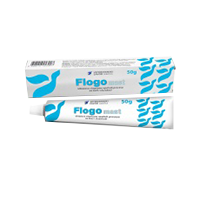


Composition:
Complex enzymes in buffer solution, white petrolatum, anhydrous lanolin, cholesterol, essential lavender oil, liquid paraffin, preservatives, herbal fragrance, marigold oil, almond oil, tocopheryl acetate.
Indications for use:
Antiseptic, antiinflammatory, regenerative, emollient and nutritive ointment for external use only. It reduces inflammation of the skin and mucous membranes with acne, pimples, ingrown hairs, ingrown nails, eczema, scratches, sore spot, itching. It intensively revitalizes and nourishes the skin from burns and frostbite and wounds that are difficult to heal.
Application:
Apply several times a day to the affected area and its surroundings in a thick layer and spread gently. If necessary, bandage or gauze can be put over treated area. Be sure your hands are washed thoroughly after using it. Avoid contact with eyes.
Presentation:
tube 50 g
Zinc-vitamin ointment
Accelerating epithelialization, drying, and healing of wounds
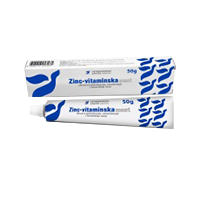


Composition:
Zinc oxide, fish oil, herbal scent, evening primrose oil, titanium dioxide, tocopheryl acetate.
Indications for use:
Regenerative, emollient and absorbent-astringent ointment for external use only. It reduces inflammation of the skin and mucous membranes and improves granulation. It also protects the epithelium, accelerates epithelialization, drying, and healing of wounds.
Application:
Apply several times a day to the affected area and its surroundings in a thick layer and spread gently. If necessary, bandage or gauze can be put over treated area. Be sure your hands are washed thoroughly after using it. Avoid contact with eyes.
Presentation:
tube 50 g
Ihtiol-kamfor ointment
Reducing inflammation of tendons, joints and soft tissues
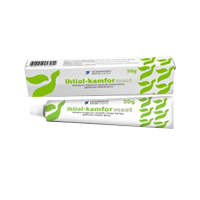


Composition:
Ammonii sulfogyrodalatis, camphor, white petrolatum, anhydrous lanolin, fish oil, St. John's Wort oil, tocopheryl acetate.
Indications for use:
Antiseptic, rubefacient, regenerative and emollient ointment for external use only. It improves circulation and skin regeneration and efficiently reduces inflammation and pain of tendons, joints and soft tissues.
Application:
Apply several times a day to the affected area and its surroundings and spread gently. If necessary, bandage or gauze can be put over treated area. Be sure your hands are washed thoroughly after using. Avoid contact with eyes.
Presentation:
tube 50 g
Buvabez
Dog shampoo
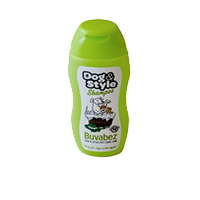


Target animal species:
Dogs
Composition:
Genapol 70, EVEMUL-B, voda.
Instructions for use:
Shake the bottle well before using it. Wet the skin and coat thoroughly with lukewarm water, and apply shampoo at several places. If the stable foam is not formed due to large ammount of dirt, repeat the procedure. Depending on the size of the dog, an average of 20-40 ml of shampoo is used, and in case of extreme dirtying, more is taken if necessary. After thorough rinsing with lukewarm water and drying, the coat should be combed with a suitable brush
Storage precautions:
Keep at temperatures above 0°C.
Shelf life:
Unlimited.
Presentation:
bottle 150 mL
Povidon jod
Solution for the preoperative disinfection of surgeons’ hands and forearms


Active substance:
Iodine 0,9-1,2% (m/v)
Intended use:
The Povidon jod preparation is intended for professional use, specifically for the preoperative disinfection of surgeons’ hands and forearms, by direct application to the skin.
Dosage and use:
The preparation is used undiluted (corresponds to a 0.9-1.2% active iodine substance) by dosing it directly from the original packaging. For the preoperative disinfection of the skin of surgeons’ hands and forearms: right before the surgical procedure, apply about 5 mL of the preparation directly to the palms and then spread it over the hands and forearms while thoroughly rubbing it in for about 5 minutes. After that, rinse the preparation from the skin thoroughly using running water.Apply the preparation up to 8 times per day.
Presentation:
bottle 100mL; bottle 500 mL
Muzol
cow udder and papillae disinfectant


Active substance:
Iodine 0,9-1,2% (m/v)
Intended use:
The Muzol preparation is used for the disinfection of cow udders and papillae after milking, by dipping or spraying. It is intended for professional and general use.
Dosage and use:
The Muzol preparation is used for the disinfection of cow udders and papillae after milking, by dipping or spraying.
It is applied undiluted (corresponds to a 0.9-1.2% active iodine substance) or diluted with water in an equal volume ratio, i.e. 100 ml of Muzol needs to be mixed with 100 ml of water (corresponds to a 0.45-0.6% active iodine substance). The preparation keeps its efficiency when diluted. If the preparation is diluted, dilution needs to be done right before use. The preparation is applied after every milking. Before Muzol is applied, the udder and papillae need to be washed with lukewarm water with no added detergents, disinfectants, etc.
The dipping of papillae is done by pouring the undiluted or diluted solution of Muzol into a 30 ml PVC cup and then dipping each papilla into the cup for a couple of seconds, making sure that its entire surface is covered with the preparation.
Spraying the papillae and the udder is done using a manual or automatic sprayer into which an undiluted or diluted solution of Muzol had already been poured. Spraying needs to be done so that the entire surface of the papillae and the udder is covered by the preparation.
Before the next milking, the papillae and the udder must be rinsed with clean lukewarm water, with no added detergents, disinfectants, etc.
Presentation:
bottle 500 mL; canister 5 L
DeSu-ALK
Liquid ethanol-based hand disinfectant


Active substance:
Ethanol 70% (v/v)
Intended use:
The liquid biocidal product has a bactericidal effect, used for the personal hygiene of humans (undamaged hand skin disinfection).For general and professional use.
Dosage and use:
The solution is used in an undiluted form. A quantity of 2-3 ml of the solution is applied to the undamaged hand skin through manual dosing or spraying from the pump 2 times, then manually rubbing it into the skin for at least 1 minute. Repeat 5-10 times per day.
Presentation:
bottle 100mL; bottle 200 mL; bottle 500 mL; bottle 1 L; canister 5 L.
SUPITOX
lice control agent


Active substance:
- Tetramethrin - 0.3 %
- Piperonyl butoxide - 1.5 %
Intended use:
It eliminates Pediculus capitis efficiently and is thus an efficient agent for controlling lice in hairy parts of the head. It eliminates all flying and crawling insects quickly and efficiently.Not poisonous for humans or animals!
Dosage and use:
As a lice control agent, SUPITOX® is applied by spraying it onto the hair until the hair is fully moist. After spraying, the hair needs to be wrapped in a scarf. After 30 minutes, the hair needs to be combed carefully and thoroughly.
After applying the preparation, the hair dries quickly, which is an additional advantage of the use of SUPITOX in practice. The quantity of a single bottle of SUPITOX® is sufficient for 10 treatments for boys or men with normal hair length, or 5 treatments for girls or adult women. The treatment must be repeated in 8 to 10 days, since this is the way to achieve the full effect. For the elimination of other insects, SUPITOX® is applied by spraying it in a closed space or by directly spraying it
Presentation:
bottle 200 mL
SU-PER POWDER
Powdery insecticide for the termination of pest insects and ticks


Active substance:
- Permethrin - 1,5% (m/m)
Intended use:
The preparation is intended for the termination of brown cockroaches (Blattella germanica L.), pharaoh ants (Monomorium pharaonis L.) and ticks belonging to the Ixodes ricinus L species.
Dosage and use:
The SU-PER POWDER preparation is applied by powdering all areas where insects stay with a sufficient amount of powder to leave a visible mark, depending on the level of infestation. Powdered surfaces should not be cleaned for some time due to the extended effect of the preparation. Keep in its original packaging, out of the reach of children and pets. Do not treat surfaces that come into contact with food. When applying, use protective gloves and avoid contact with skin. For a short period of time after the treatment, avoid spending time in the treated facilities. Children and pets must not come into contact with the treated surfaces. The usage interval is in the reappearance of insects.
Presentation:
bottle 100 g
SU-PER EC 25 concentrate
Liquid concentrated pest insect control agent


Active substance:
- Permethrin - 25% (m/v)
Intended use:
The preparation is intended for the termination of brown cockroaches (Blatella germanica L.) and houseflies (Musca domestica L.) in households (except for in rooms where people live and spend extended amounts of time), the catering industry, warehouses, and animal husbandry facilities.
Dosage and use:
SU-PER EC 25 Concentrate is applied dissolved, 100 ml of concentrate in 5 l water per 100 m2. The solution is applied by spraying it along the walls, in cracks and behind and below furniture, around water supply pipes and sewerage outlets, and in places where insects most often stay. After diluting it in a way that fits the intended purpose, pour the contents into a plastic spray bottle and treat the surfaces by spraying. The usage interval is in the reappearance of insects.
Presentation:
bottle 100mL; bottle 1 L
SURADIOLON pellets
Mouse and rat control agent


Active substance:
- Bromadiolon - 0,005% (m/m)
Intended use:
Suradiolon® pellets are used for controlling mice and rats in households, farms, silos, warehouses, industrial facilities and other closed areas and yards.
Dosage and use:
Pellets should be placed in locations where the rodent activity is at the highest level. Placed baits should be controlled occasionally and replenished, for as long as the activity of rodents is notable. In the case there is a danger of domestic animals or children consuming the bait, it should be placed in boxes, tubes or specially designed boxes.
Control of mice - 1-2 piles of bait (25 g each) need to be placed using a plastic spatula in those locations where mice spend most time (where their excrement is, close to holes or paths where they pass, or directly into rodent holes, bait boxes, etc.). If the number of mice is higher, place 1-2 piles of bait weighing 25 g on each 5 m2. Bait is placed either on cardboard sheets or boxes, or directly into rodent holes or bait boxes. Once placed, bait needs to be left in place for as long as the activity of mice is notable, usually 10-14 days.
Control of rats - The best results in the extermination of rats are achieved if the bait is placed in places where the activity of rats is most notable (close to their excrement, places where they eat and places of passage). It should be noted that rats prefer to eat in sheltered and familiar places. Otherwise, the consumption of the placed bait can happen only after 2-3 days. Bait is to be placed on cardboards, paper trays or specially prepared boxes for feeding. Place piles of bait weighing 25-50 g in selected places in order for less dominant rats to have a chance to consume it as soon as possible. If the number of rats is higher, place 2 to 3 piles of bait weighing 25-50 g on each 5-10 m2. Once placed, the bait needs to be left in place for as long as the activity of rats is notable, usually 10-14 days.
Note - Placed bait should be checked 2-3 times in 5-7 day intervals and in cases of extensive consumption it should be replenished. If signs of bleeding are spotted on the placed baits, it is necessary to replace them with fresh ones. If possible, it is recommended to remove other types of food and various waste, and to keep the place in order and clean during deratization. In case there is a danger of domestic animals or children consuming the bait, it should be placed in boxes, tubes or specially designed batteries. The preparation must not be uncontrollably dispersed in open areas such as meadows and crops, as well as in the immediate vicinity of open water surfaces (less than 20m). Also, the preparation must not be dropped from a plane (for agricultural protection).
Presentation:
bag 1 kg; bag 10 kg
SURADIOLON briquettes
Mouse and rat control agent


Active substance:
- Bromadiolon - 0,005% (m/m)
Intended use:
Suradiolon® paraffin-protected briquettes are used to exterminate mice and rats in households, warehouses, farms, yards, industrial and other facilities and are placed in areas and places where humidity and bad weather can easily damage the placed bait.
Dosage and use:
Suradiolon® paraffin-protected briquettes should be placed in places where the activity of rodents is at the highest level.
Control of mice - Use smaller quantities of bait (briquettes have the form of a round cake and weigh 100 g; to get the 25 g dose for mice, break it into 4 pieces), placed in those locations where the mice spend the most time (where their excrement is, close to holes or paths they take, etc.). If the number of mice is higher, place 1-2 baits of 25 g for each 5 m2. Bait is placed either on cardboard sheets or boxes, or directly into rodent holes or bait boxes. Once placed, the bait needs to be left in place for as long as the activity of mice is notable, usually 10-14 days.
Control of rats - Best results in controlling rats are achieved if the bait is placed in places where the activity of rats is most notable (close to their nests, places where they eat and places of passage). It should be noted that rats prefer to eat in sheltered and familiar places. Otherwise, the consumption of the placed bait can happen only after 2-3 days. Use 50 g bait (if using a 100 g bait that has the shape of a round cake and weighs 100 g, a 50 g dose for rats is obtained by breaking it into 2 pieces). Bait is placed in selected places where less dominant rats will have a chance to consume them as soon as possible. If the number of rats is higher, place 2-3 baits weighing 25-50 g per 5-10 m2. Bait is to be placed on cardboards, paper trays or specially prepared boxes for feeding. Once placed, the bait needs to be left in place for as long as the activity of rats is notable, usually 10-14 days.
Note - Placed baits should be checked 2-3 times in 5-7 day intervals and in cases of extensive consumption they should be replenished. If signs of bleeding are spotted on the placed baits, it is necessary to replace them with fresh ones. If possible, it is recommended to remove other types of food and various waste, and to keep the place in order and clean during deratization. In the case there is a danger of domestic animals or children consuming the bait, they should be placed in boxes, tubes or specially designed batteries.The preparation must not be uncontrollably dispersed in open areas such as meadows or crops, as well as in the immediate vicinity of open water surfaces (less than 20m). Also, the preparation must not be dropped from a plane (for agricultural protection).
Presentation:
box 200 x 50g; box 100 x 100g
- Beogradski put 123
- 24106 Subotica, Serbia
- +381 24 624 100
All rights reserved Vetzavod Subotica